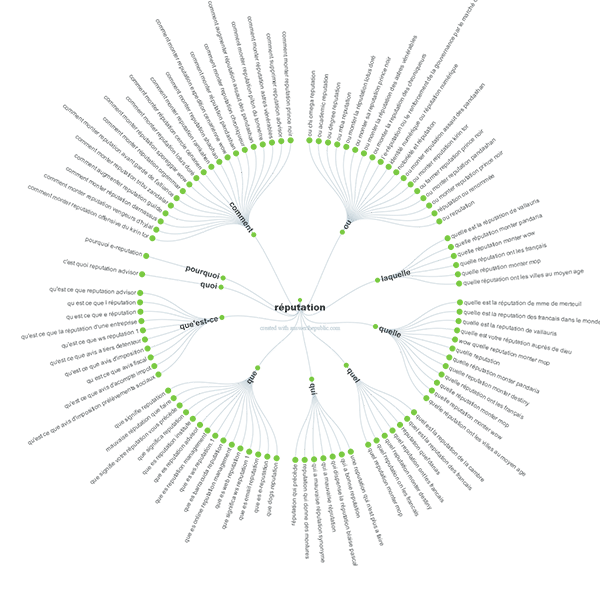How can you improve your Google positioning in 2020? A study by the very reliable SearchMetrics agency analyses current referencing factors and is very rich in information. Lots of SEO agencies have been wondering lately about the best SEO strategy to adopt since the arrival of the RankBrain algorhythm based on artificial intelligence techniques, such as how to efficiently structure content and whether social networks are really important for improving positioning.
How to improve the natural referencing of your website
Even if it is difficult to extract some universal rules, as Google algorhythms are adapting themselves more and more in real time, here are six tips and conclusions based on the study which could help SEO and marketers to see more clearly in their quest for better natural positioning.
1. Think about content relevance
Nowadays, Google results are influenced more and more by context. The Mountain View firm even uses its own data (from Chrome, Analytics and Android) to measure user satisfaction and to supply them with more and more relevant results.
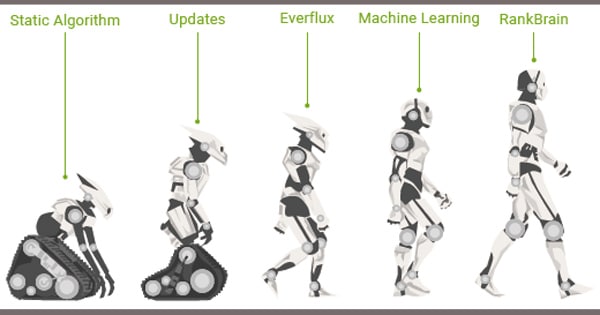
Evolution of the Google algorhythm according to SearchMetrics. © SearchMetrics.
How can you establish a relevant content strategy in this context? First of all, according to SearchMetrics, it has become essential to determine the type of content to publish according to the chosen target. SearchMetrics uses the example of a simple recipe search on Google. In this example, rather than publishing a long text, wouldn’t it be better to write a list with various key points with a video to accompany it?
Once the content type has been found, it is necessary to invite the web user and search engines to carry out a “holistic” content search, in other words one designed from a “global” or “integral” perspective. The aim here is to respond precisely to the web user’s question, taking into account his real intention: what is he looking for, why is he looking for it and what sort of information does he want to get from his search?
The answer to these questions must allow a better adaptation to the web user’s query, taking into account all the problems that might come up through his query.
To reach this integral content, individual search words need to be gathered and structured in more global semantic fields in which relevant terms related to identical or similar themes are grouped together according to the search intentions.
This global approach, which is semantically attractive and based on quality texts, must not only allow texts to be read and shared more on social networks, but must also allow good positioning on Google for many different queries at one time. The long tails created, which often contain more than three keywords, will offer a smaller search volume, but will allow web users’ queries to be answered more precisely and thus will potentially allow the arrival of a more qualified audience.
To know what these queries are, you can use keyword tools such as “Answer the public“ which extracts Google suggestions and associates them with the questions or prepositions most often typed into Google.
Extract of suggestions offered by the “Answerthepublic” too. @ Answerthepublic.
How did SearchMetrics arrive at this conclusion? The agency started with the study of the best-positioned US websites:
- It’s no surprise that the URLs with the content judged most relevant occupy places 3 to 6 of the Top 10 SearchMetrics ranking, the two first spaces being reserved for brand sites benefitting from their notoriety and popularity.
Comparison of content relevance on websites in relation to their Google classification. © SearchMetrics
- Also, it can be seen that content is longer and longer, 1,633 words for desktop computers and 1,222 for mobiles. It would appear that the explanation lies in the production of this holistic or global approach mentioned above, on behalf of the best-positioned sites. It can also be added that a well-developed, well-crafted and illustrated article generally obtains a higher number of shares and natural backlinks, which helps its positioning owing to a virtual SEO circle effect.
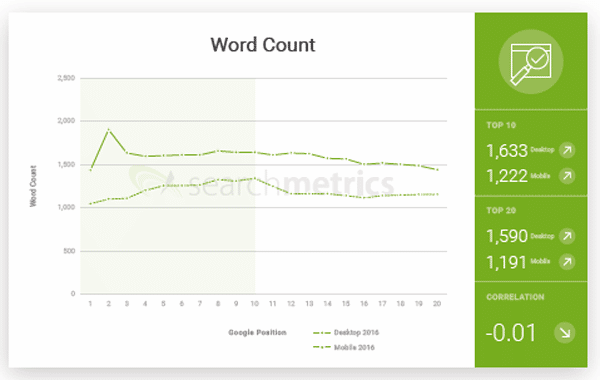
- Comparison of words on pages in relation to their Google classification between desktop and mobile sites in 2016. © SearchMetrics
- Keywords are, compared to last year, less present in the content, title, H1 and H2 of pages located in the Top 20 ranking.
The Reputation VIP team has developed Semji, a semantic analysis solution, to help you produce impactful, visible content.
Semji is the content optimisation platform which improves the performance of your pages and articles and boosts their visibility on SERPs. Coupled with artificial intelligence, in just a few seconds Semji analyses your content and offers recommendations to carry out, such as:
- Suggestions of new themes to raise
- Semantic enrichment of your pages and articles by working on new keywords searched by your audience
- Optimise your Hn tags
- Inject a link volume to integrate into your content
Semji helps your content stand out in relation to your competitors This tool targets themes your audience is interested in by also responding to Google demands. Semji is the content marketing solution for improving your positioning on search engine results pages.
2. Secure the website using HTTPS
For sites with data exchange including passwords and credit cards, going through a secure HTTPS connection is obligatory. From 2017, the Chrome 56 browser has displayed pages with an HTTP connection as “unsecured”. Nowadays, more than half of the pages in the Top 10 currently use an HTTPS connection.
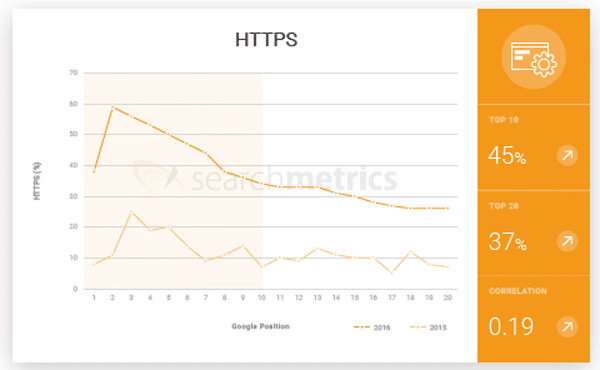
Comparison of the number of websites with an HTTPS connection between 2016 and 2015 in relation to their Google classification. © SearchMetrics
3. Mobile-friendly websites are essential
Currently, according to the SearchMetrics study, 100% of the websites in the Top 100 are mobile-compatible (responsive, dedicated website, dynamic serving). Mobile phones have gained such weight that Google is getting ready to launch the “mobile first index”: Up to now, Google took account of “desktop” pages to index its pages, but Google will now take into account the content of mobile pages to draw up its index.
In order to allow for good mobile user experience, a good balance needs to be found between rich content (with pictures, video etc.) and the page’s loading speed. We would recommend using the GTmetrix website which centralises the Google Pagespeed and Yahoo Yslow scores and offers suggestions for improving both websites with the opportunity to generate a video to visualise the website’s display second by second.
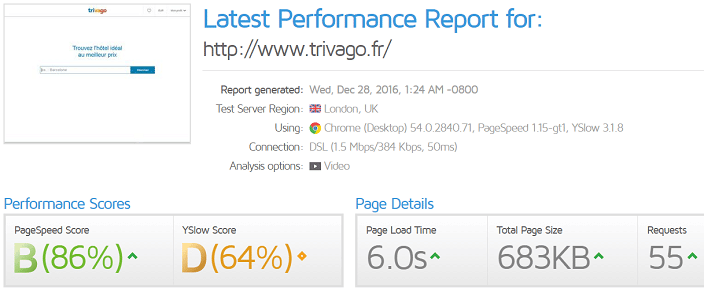
Overview of the GTmetrix performance scores of Trivago.fr
The SearchMetrics study shows that social signals are particularly active for the websites located in the first two places on the list. Then its importance quickly recedes (particularly for Twitter and Google Plus). This can be explained by the fact that the first place in the classification is generally attributed to brands benefitting from their notoriety on social networks. There is a strong correlation between social signals and ranking. As you know, correlation doesn’t necessarily mean causality, so the only certainty is that, in relation to last year, the number of shares and likes of the most highly positioned websites has increased. It is the clear observation that brands are working and improving their image on social networks even more.
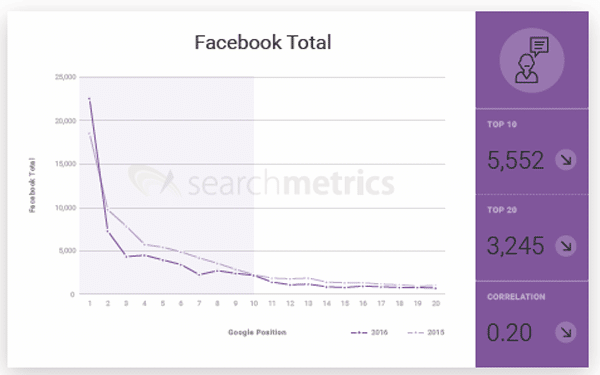
Comparison between 2016 and 2015 of the number of social signals from Facebook on websites in relation to their Google classification. © SearchMetrics
5. Improve user experience
Although not as numerous in the websites studied compared with two years ago, the SearchMetrics study continues to make internal links an essential element for good positioning. Indeed, internal links allow web users and search engines to better understand and explore the website’s structure. It is therefore more useful than ever to have a well thought out website architecture to improve user experience. Another tip, again for developing user experience, is to have pages which load quickly and legibly on all media. The loading time of pages in the Top 10 is between 7 and 8 seconds. Google recommends a loading time of 3 to 4 seconds.
6. Correlation remains important for backlinks
The study highlights the still obvious correlation between the presence of backlinks and good Google positioning. The best positioned US websites looked at on Google are therefore those which have the most backlinks.
With this in view, opt for a netlinking strategy, with contextualised links enshrined in high-quality content following the evolutions of the Google algorhythms.
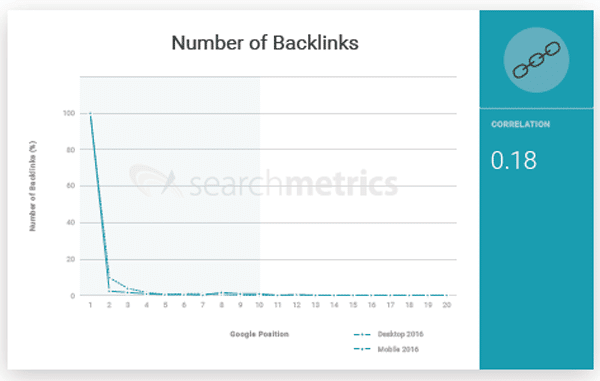
Comparison of the number of backlinks on websites in relation to their Google classification between 2016 and 2015. © SearchMetrics
In spite of this strong correlation, it would appear that backlinks lose some of their importance. This decrease may be explained by the increase in mobile traffic. Indeed, owing to their nature, mobiles are not suitable for “classical” link creation, while these are used massively for sharing an article on social networks.
Limited to the US version of websites and based on correlations, in other words the recognition of a fact without any direct causal analysis of it, this study should be taken in a necessarily SEO-critical frame of mind; it should be taken for what it is, a Big Data study based on correlation statistics. Regarding backlinks, the recent declaration by Andrey Lipattsev, Search Quality Senior Strategist at Google, on the importance of links for Google should be kept in mind. These remain essential among the factors for good Google positioning. A comprehensive and relevant content without a backlink or with low-quality backlinks would have difficulty emerging from SERPs (search engine results).
Nevertheless, this study remains rich in information. It shows, if need be, that it is necessary to respond more and more specifically to web users’ expectations by offering them the most complete user experience in order to improve your Google positioning.
This article has been written in conjunction with our SEO experts. If you are searching for an SEO agency able to support you in your strategy to acquire organic traffic and increase your SERP visibility on Google, please get in touch with our experts. Our experience and tools will help us carry out a full SEO audit of your website and offer you natural referencing support solutions to suit your objectives and budget.

